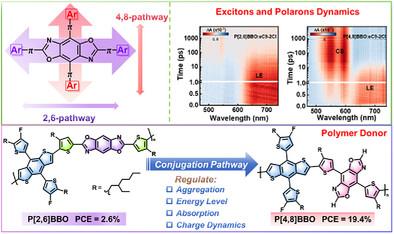当前位置:
X-MOL 学术
›
Adv. Mater.
›
论文详情
Our official English website, www.x-mol.net, welcomes your
feedback! (Note: you will need to create a separate account there.)
Conjugation Pathway of Benzobisoxazoles in Polymer Donors Mediates the Charge Management and Enables Organic Solar Cells with Record Certified Efficiency
Advanced Materials ( IF 27.4 ) Pub Date : 2025-06-04 , DOI: 10.1002/adma.202503702
Miao Liu, Lunbi Wu, Yulong Hai, Yongmin Luo, Yao Li, Rouren Chen, Yue Ma, Tao Jia, Qingduan Li, Sha Liu, Ruijie Ma, Yue-Peng Cai, Jiaying Wu, Gang Li, Shengjian Liu
Advanced Materials ( IF 27.4 ) Pub Date : 2025-06-04 , DOI: 10.1002/adma.202503702
Miao Liu, Lunbi Wu, Yulong Hai, Yongmin Luo, Yao Li, Rouren Chen, Yue Ma, Tao Jia, Qingduan Li, Sha Liu, Ruijie Ma, Yue-Peng Cai, Jiaying Wu, Gang Li, Shengjian Liu

|
Charge management plays a pivotal role in achieving high-performance bulk heterojunction (BHJ) organic solar cells (OSCs). In this study, two efficient polymer donors are designed, P[4,8]BBO and P[2,6]BBO, by regulating the conjugation pathways of benzobisoxazoles (BBO) through 4,8- and 2,6-linkages, respectively. Comparing to P[2,6]BBO, the isomer of conjugation pathway has been proved to enable P[4,8]BBO a shallower highest occupied molecular orbital (HOMO) energy level of −5.20 eV, significantly enhanced luminescence efficiency, and reduced aggregation property. These improvements lead to a dramatic increase in device efficiencies from 2.6% for P[2,6]BBO:eC9-2Cl to 19.0% for P[4,8]BBO:eC9-2Cl. The combined characterizations show that a better comprehensive charge management can be reached in P[4,8]BBO:eC9-2Cl-based OSCs, yielding a significantly higher short-circuit current density (JSC) and fill factor (FF) parameters compared to P[2,6]BBO:eC9-2Cl-based ones. Furthermore, P[4,8]BBO demonstrates good applicability and can achieve an impressive efficiency of 19.4% in all-polymer solar cells with a third-party certified efficiency of 19.1%. This work highlights the critical role of conjugation pathway isomerism in mediating polymeric properties and advancing the development of high-performance multifunctional photovoltaic materials.
中文翻译:

苯并异噁唑在聚合物供体中的共轭途径介导电荷管理,使有机太阳能电池具有创纪录的认证效率
电荷管理在实现高性能体异质结 (BHJ) 有机太阳能电池 (OSC) 方面起着关键作用。在本研究中,通过分别通过 4,8 键和 2,6 键调节苯并异恶唑 (BBO) 的共轭途径,设计了两个高效的聚合物供体 P[4,8]BBO 和 P[2,6]BBO。与 P[2,6]BBO 相比,偶联途径的异构体已被证明使 P[4,8]BBO 具有较浅的最高占据分子轨道 (HOMO) 能级,为 -5.20 eV,显著提高了发光效率,并降低了聚集特性。这些改进导致器件效率从 P[2,6]BBO:eC9-2Cl 的 2.6% 急剧提高到 P[4,8]BBO:eC9-2Cl 的 19.0%。综合表征表明,与基于 P[2,6]BBO:eC9-2Cl 的 OSC 相比,基于 P[4,8]BBO:eC9-2Cl 的 OSC 可以实现更好的全面电荷管理,从而产生显着更高的短路电流密度 (JSC) 和填充因子 (FF) 参数。此外,P[4,8]BBO 表现出良好的适用性,在全聚合物太阳能电池中可以实现令人印象深刻的 19.4% 的效率,第三方认证的效率为 19.1%。这项工作强调了共轭途径异构在介导聚合物特性和推动高性能多功能光伏材料开发中的关键作用。
更新日期:2025-06-04
中文翻译:

苯并异噁唑在聚合物供体中的共轭途径介导电荷管理,使有机太阳能电池具有创纪录的认证效率
电荷管理在实现高性能体异质结 (BHJ) 有机太阳能电池 (OSC) 方面起着关键作用。在本研究中,通过分别通过 4,8 键和 2,6 键调节苯并异恶唑 (BBO) 的共轭途径,设计了两个高效的聚合物供体 P[4,8]BBO 和 P[2,6]BBO。与 P[2,6]BBO 相比,偶联途径的异构体已被证明使 P[4,8]BBO 具有较浅的最高占据分子轨道 (HOMO) 能级,为 -5.20 eV,显著提高了发光效率,并降低了聚集特性。这些改进导致器件效率从 P[2,6]BBO:eC9-2Cl 的 2.6% 急剧提高到 P[4,8]BBO:eC9-2Cl 的 19.0%。综合表征表明,与基于 P[2,6]BBO:eC9-2Cl 的 OSC 相比,基于 P[4,8]BBO:eC9-2Cl 的 OSC 可以实现更好的全面电荷管理,从而产生显着更高的短路电流密度 (JSC) 和填充因子 (FF) 参数。此外,P[4,8]BBO 表现出良好的适用性,在全聚合物太阳能电池中可以实现令人印象深刻的 19.4% 的效率,第三方认证的效率为 19.1%。这项工作强调了共轭途径异构在介导聚合物特性和推动高性能多功能光伏材料开发中的关键作用。


















































 京公网安备 11010802027423号
京公网安备 11010802027423号